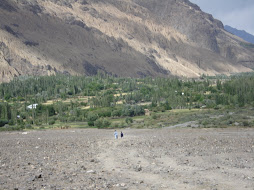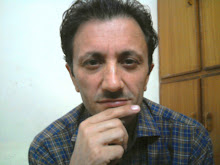Chitral is delicately balanced between Afghanistan and Swat, in the Hindu Kush mountains. Given this (interesting?) geographical location I had a major internal struggle over whether to go with a colleague, who had invited me to stay with his family over Eid. But both the Foreign Office and VSO said the area is peaceful, so I didn’t give in to fear and boldly went to a place where many other foreigners have been before.
After arriving in Chitral, after a mere 45 minute flight, I had to go to the District Police Office so I could register as a foreigner. After that surprisingly quick process, we started on the journey to Kafiristan – the Kalash valleys. The Kalash valleys are famous because the people there are the only non-Muslims in a large area. They have their own very different religion and traditions, and it is thought that they are descendents from the army of Alexander the Great.
The journey was quite incredible – the mountains were huge, the valleys green, and the road was, well very bumpy, to say the least. I thought I was getting used to mountain roads, but at some points this one was completely gauged out of granite rock – huge tons of rock seemed to be hanging delicately over the road. Plus, we had a normal car rather than one built for such roads, which clattered considerably, so I was rather worried about the state of the tyres.
As we got closer I felt more and more guilty that I was going to gawp at people like they were museum exhibits. But actually when we got there the guy I was with, Asif, had friends there – he seems to have contacts everywhere (used to be a politician!!). So we met his friends, who made tea for us, and then we were shown around the village. Walking around the streets was wonderful. It seemed to an outsider to be a gentle and slow rhythm of life – women were walking around carrying produce, chatting in the streets, kids were playing, and everyone smiled and greeted us.
The women’s clothes were colourful, intricately designed and made, and very beautiful. But it definitely wasn’t a village untouched by modernity - there were adverts for pepsi, and signs basically saying ‘NGO x woz ‘ere’. I really didn’t like that, it was like the NGOs were taking ownership over the village, and saying ‘congratulations to us, we’ve bought these people into the modern world.’ But at the same time I was told about one Kalash woman who had started her own NGO. And the Kalash people obviously hold very closely onto their culture. When women give birth or menstruate they go to a special house where men are not allowed. If a man goes beyond a certain line he has to pay a fine of one goat.
One thing really shocked me – Asif pointed to a particular direction, and said – walk three hours in that direction (admittedly over rather a large mountain), and you get to Afghanistan, Nuristan, and Taliban central. (Behind the mountain in the photo: Afghanistan).
I couldn’t take it in that I was so close to such a dangerous area, yet the Kalash valleys were completely safe and peaceful. I assume that the nature of the villages is very similar in Nuristan and Kafiristan – remote, mountainous, similar crops being grown, life dictated by the seasons. But how can villages so close to each other geographically have people with such a different attitudes to life, cultures and traditions?
In a second village we visited we went to the graveyard which was fairly disturbing, as they used to have open graves (not any more). As much as I tried not to look, I could still see bones in some of the old graves. After Asif met someone else he knew, we started on the long drive back to Chitral, but the excitements of the day were not over. When we got back into mobile phone range I got some texts from VSO saying that Islamabad airport had been closed and all flights suspended due to a bomb scare. It must have happened just after we left. I’m ashamed to say that I had another major panic attack. But I spoke to my parents who have completely changed their tune from saying get on the first flight back to the UK, to saying: oh just enjoy it. So I will, and decided to postpone worrying about how to get back until the time came.
We stayed with Asif’s brother in Chitral. Chitral city is quite conservative – there were no women in the bazaar, so I slightly stood out, even though I had my head covered. Even Ismaili women, who I stayed with, completely covered their face when they went out, and would not venture out without a man, even though in their village they were a lot freer. I was wondering why Chitral is so peaceful given its proximity to Swat, Afghanistan and some tribal agencies. Chitral city itself is mainly Sunni, as it lower Chitral, but upper Chitral is mainly Ismaili. However, there is quite a lot of inter-marriage between the sects. A couple of years ago when there were Taliban incursions into Chitral there were large and peaceful protests. In Dir at the moment, which borders lower Chitral and Afghanistan, the Taliban are making incursions, but citizens are taking matters into their own hands by forming militia. The other week four Taliban were caught in this way. And lists of known Taliban are published and publicly displayed.
The day after Kafiristan we embarked on the six hour journey to Baleem, Asif’s village. Asi kept warning me it was going to be a long and difficult journey, and I thought I was prepared after yesterday. However, we travelled in a local form of transport, so people were packed in like sardines, and several men were on the roof.
I was lucky enough to be in the front seat, but sat next to Asif with barely room to breathe. The journey was stunning though – we could see Terech Mir, the largest mountain in the Hindu Kush range, for a long time which was amazing, especially when the sun was setting. Although Asif had repeatedly told me that Chitral was green (in security terms – it was completely safe), when we got to one village he casually mentioned that this was where Osama Bin Laden’s left hand man was killed, and it was his cousin who killed him over a land dispute. I only managed a weak smile in response to that.
When we got to the village it was 11 o’clock at night, pitch dark and freezing cold. There were no roads in the village, so we had to walk about 20 minutes to reach Asif’s house. When we got there though Asif showed me to his own guest house! I was so tired I went almost immediately to sleep, to the comforting sound of the call of the jackal. --Courtesy Georgechetwynd.blogspots.com
Saturday, October 25, 2008
Subscribe to:
Post Comments (Atom)
Awesome and rugged

Beauty of Chitral

Kishmanja, a beautiful village in Yarkhun valley
Lush green

DIZG: threatened by floods

The legendary village of Ayun in Chitral

On way to Bumburet
Dizg, Yarkhun

Blog Archive
-
▼
2008
(195)
-
▼
October
(50)
- Sit-in staged against delay in Sheshi power house ...
- Govt warned against price hike
- Postgraduate college still a pipe dream in Chitral
- Severe food crisis may hit Chitral
- SELF HELP: Life On The Wrong Side
- Chitral seminar calls for protection of women's ri...
- Education, developmet in Chitral
- Aga Khan's visit still not confirmed
- Chitral: the secrets of my peace!
- Brep: power house project hits snags
- CM okays uplift projects for Chitral
- Work on Yarkhun bridge begins
- NBF readers' club scheme coming to Chitral
- Met official killed in Chitral
- Eliminating women trafficking our collective respo...
- Face of man accused of women trafficking blackened...
- Drosh residents protest power outages
- Rumi’s thoughts can bring stability to world
- Aga Khan's visit to Chitral - Letter 2
- Aga Khan's visit to Chitral -Letter 1
- Lowari tunnel opening to be a gigantic step, says NHA
- Arrangements for Lowari festival reviewed
- Widow's allegations denied
- Proposed Lowari tunnel festival - Letter
- Multi-stakeholder forum - Letter
- Arrangements for Lowari tunnel festival discussed
- Aga Khan to visit Chitral in mid-November?
- Body on women's rights formed in Chitral
- US drones fly over Chitral?
- Five cases of violence against women in Chitral in...
- Bids for trophy hunting invited
- Over 3,000 Benazir income support cards distribute...
- Preparations to welcome Aga Khan in full swing in ...
- Anti-polio drive begins in Chitral
- NHA agrees to open Lowari tunnel in winter
- MNA justifies supporting PPP
- Timely completion of uplift projects ordered
- Impersonator arrested
- Opening of Lowari tunnel for light traffic demanded
- Shortage of technical staff mars uplift in Chitral
- Bajaur blockade to hurt Chitralis too
- Upper Chitral residents to pay bills locally
- Chitral colleges lack hostel facilities
- Over 75,000 children to be administered polio drops
- Trade corridor: paradigm shift we’ve been waiting ...
- Lowari tunnel will be opened this winter
- Woman commits suicide in awi
- Islamabad-Chitral flights still being mismanaged
- JI leader sees conspiracy to establish Ismaili state
- Most Chitralis unable to go home on Eid due to hig...
-
▼
October
(50)
About Me

- Zar Alam Khan Razakhel
- Village Dizg, Yarkhun valley, Chitral, Pakistan
- I blog at http://chitraltoday.net (ChitralToday) about Chitral, its people, culture, traditions and issues. I have been writing about Chitral since 2000. Chitral is a scenic valley in the extreme north-west of Pakistan.
No comments:
Post a Comment